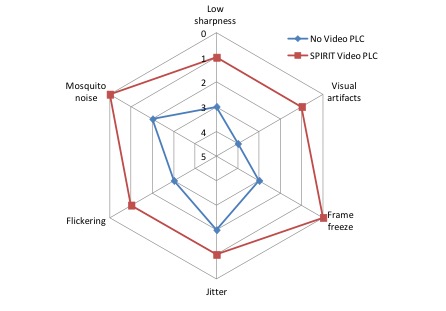Video Packet Loss Concealment (PLC)
Stable Video over Unstable Networks
Compressed video transmitted over the Internet suffers from network latency, difference in the average latency time of packets (jitter), bandwidth congestion and instability, packet loss and reordering, etc. Such network impairments affect transmitted data and cause significant degradation in percepted subjective video quality. Network delay and packet loss are the most critical issues which harmfully affect real-time video delivered to end users. Delay typically occurs when available network bandwidth is lower than required for particular media stream. Packet loss occurs when data don’t reach their intended destination at all. Rise of multiple types of connected devices and coexistence of traditional Internet access channels with wireless 3G/4G and Wi-Fi cause even stronger issue for quality video communication.
Challenges in Video Communication Over Wireless Networks
Available Bandwidth
- Typically Wi-Fi networks offer lower bandwidth to end users as compared to wired networks.
- Wireless applications may not be able to utilize the maximum available bandwidth due to crowded access points and multiple re-transmissions.
Interference
- Interference of Wi-Fi networks prevents from achieving their full capacity. It affects video quality due to lower bandwidth available.
- The key impact is increased packet loss and more frequent re-transmission of key video frames, all leading to increase in delay.
Variable Channel Conditions
- Mobility increases the variations in channel conditions between the transmitting end user device and Wi-Fi access point (receiver).
- Wireless signal strength in relation to distance between the transmitter and receiver is subjected to inverse-square law (Eg: If distance grows by 2x, the signal strength drops by 4x). This affects the available bandwidth and decreases the video quality.
SPIRIT Video PLC tackles all these challenges to drive seamless video communication in adverse network environment
Video PLC helps people and devices to communicate with video from virtually any network and location. In case network impairments occur during video call, SPIRIT Video PLC technology fills in gaps in video stream using data from the current video call history received and successfully decoded shortly before. Most relevant dynamic video scene from the history takes place in video stream to conceal the missing part. SPIRIT Video PLC enables smooth and comfort real-time video calling and interactive multiparty video conferencing.
SPIRIT Video PLC prevents watcher’s frustration

- Low sharpness: blurry video with very low number of image details, no crisp boundaries between different tones or colors.
- Visual artifacts: appear when decoded video frames have missing macroblocks (bits of data).
- Frame freeze: frame halts as a result of unavailability of new frames due to network congestion or packet loss etc.
- Jitter: perceived as unnatural motion due to variations in transmission delay as a result of, e.g., fluctuations in the available bandwidth or network congestion.
- Flickering: noticeable discontinuity between consecutive frames as a result of a too-low frame rate together with high texture, coding artifacts, or motion content.
- Mosquito noise: appears as temporal shimmering seen mostly in smooth textured areas produced by ringing and prediction error due to motion compensation mismatch.
- BFCP
- H.323
- Skype for Business Gateway
